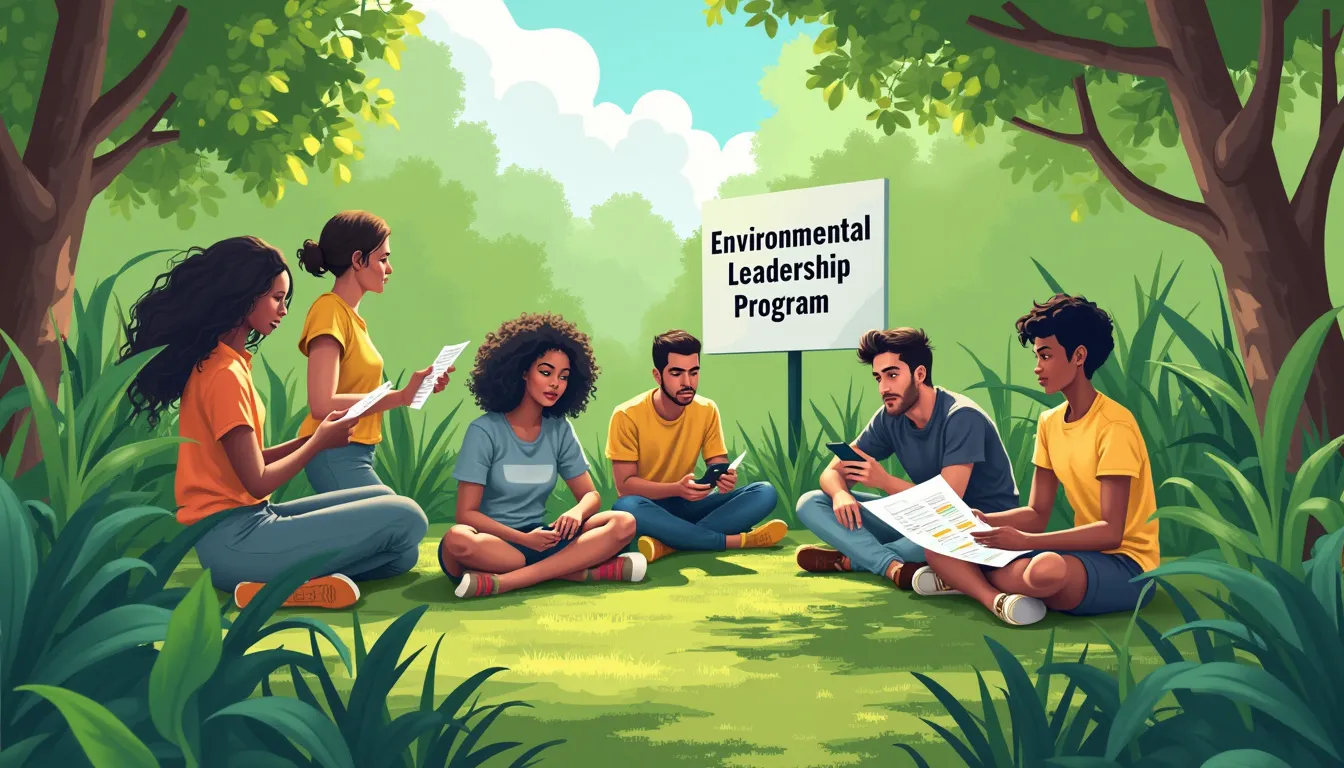In a world increasingly aware of environmental challenges, empowering individuals to lead the charge in conservation has never been more crucial. The Environmental Leadership Program stands at the forefront of this mission, equipping passionate changemakers with the skills, knowledge, and network to drive impactful environmental initiatives. Leadership, especially in environmental conservation, isn’t just about guiding others; it’s about inspiring collective action toward a sustainable future. The program highlights the profound role that informed and motivated leaders can play in conserving our natural world.
Established with a vision to create a network of dedicated environmental stewards, the Environmental Leadership Program has evolved into a beacon of hope and progress. Originating in the early 2000s, the program has adapted over the years to address emerging environmental issues while providing cutting-edge training and resources. Its comprehensive approach ensures that participants are not just knowledgeable, but also prepared to implement sustainable solutions in their communities and beyond.
By focusing on cultivating leadership qualities in the context of environmental protection, the program goes beyond traditional education. It marries practical experience with theoretical knowledge, fostering a unique environment where future leaders can thrive. As our planet faces unprecedented ecological threats, initiatives like the Environmental Leadership Program are essential in forging a path to a greener, more sustainable future.
Introduction to the Environmental Leadership Program
A growing need for environmental stewardship has propelled the development of innovative initiatives like the Environmental Leadership Program (ELP). This transformative program is designed to cultivate leaders equipped to tackle pressing ecological challenges. But what exactly does the Environmental Leadership Program entail, and why is leadership pivotal in environmental conservation?
Overview of the Environmental Leadership Program
The Environmental Leadership Program stands as a dynamic and practical approach to fostering future environmental advocates. It equips participants with the necessary skills, knowledge, and networks to drive meaningful change. From understanding complex environmental issues to implementing sustainable practices, the ELP nurtures individuals ready to spearhead conservation efforts within their communities and beyond.
Participants of the program engage in a multifaceted curriculum that combines theoretical understanding with practical application. The unique blend of classroom learning and real-world experiences ensures that graduates are not just knowledgeable, but also proficient in executing sustainable solutions. Furthermore, the program focuses on building a robust community of like-minded individuals committed to environmental advocacy, creating an enduring impact that extends well beyond the duration of the program.
Importance of Leadership in Environmental Conservation
The significance of leadership in environmental conservation cannot be overstated. Effective leaders in this field drive critical projects, inspire community action, and influence policy at various levels. Leadership here implies not just guiding teams but also embodying a vision of sustainability and rallying others to this cause.
Leaders serve as catalysts for change, whether through innovative solutions like renewable energy projects or conservation efforts across fragile ecosystems. They possess the skills to navigate complex environmental issues and the ability to mobilize communities towards sustainable practices. With global environmental challenges becoming increasingly acute – from climate change to biodiversity loss – the world needs leaders who can develop and implement strategies that positively impact our planet.
The Environmental Leadership Program specifically addresses this need by enhancing the capacity of individuals to lead effectively. By focusing on leadership development, the program ensures that participants are not only passive recipients of knowledge but are also active proponents for change, equipped with the tools to inspire and mobilize others.
Brief History and Development of the Program
The Environmental Leadership Program has evolved over the years, adapting to the growing and changing needs of environmental conservation. Initially conceptualized as a way to bridge the gap between theoretical knowledge and practical application, the ELP has expanded its scope and influence since its inception.
The origins of the program can be traced back to the early 1990s when environmental awareness was gaining momentum. Recognizing a gap in leadership education within the realm of environmental science, visionary educators and environmentalists founded the ELP with the goal of grooming a new generation of environmental leaders. The program quickly garnered attention for its innovative approach and comprehensive curriculum that combined education, fieldwork, mentoring, and networking.
Over the decades, the program has incorporated feedback and trends from the rapidly evolving environmental landscape. Technological advancements, emerging ecological crises, and evolving sustainability practices have all influenced the continuous improvement and expansion of the ELP. As a result, it remains a relevant and cutting-edge program that attracts passionate individuals dedicated to making a difference.
The Environmental Leadership Program now boasts a rich history of producing influential leaders who have gone on to make substantial contributions in various sectors, including government agencies, non-profits, academic institutions, and private corporations. Its alumni network is a testament to its success, with former participants continuing to collaborate, support each other, and work towards common environmental goals.

Core Components of the Environmental Leadership Program
The Environmental Leadership Program (ELP) is structured meticulously to provide a robust educational foundation, practical experience, and extensive networking opportunities. At the heart of the ELP are its core components, each designed to nurture well-rounded and capable environmental leaders. Here, we’ll break down these pivotal elements: curriculum and training modules, hands-on experience and fieldwork, mentorship and networking opportunities, and success stories and case studies.
Curriculum and Training Modules
The ELP’s curriculum is comprehensive and interdisciplinary, blending theoretical knowledge with real-world application. Courses cover a wide array of topics such as environmental policy, sustainable business practices, ecosystem management, and environmental justice. This modular approach ensures participants gain a holistic understanding of environmental challenges and solutions.
For instance, a module on sustainable business practices might delve into how companies can reduce their carbon footprints through innovative technologies and sustainable supply chains. Simultaneously, it will highlight regulatory frameworks and incentives that support such transitions, preparing participants to drive change within their organizations.
Moreover, specialized workshops and seminars by industry experts provide insights into cutting-edge research and trends, keeping participants up-to-date with the latest advancements and strategies in environmental conservation.
Hands-On Experience and Fieldwork
One of the standout features of the ELP is its emphasis on hands-on experience. Learning in the classroom is crucial, but applying that knowledge in real-world settings is where true leadership skills are honed. Fieldwork components vary from local community projects to international conservation efforts, offering a broad spectrum of experiences.
For example, a participant might find themselves working on a coastal restoration project, learning about the dynamics of marine ecosystems and the importance of biodiversity. Meanwhile, another participant could be involved in an urban greening initiative, discovering how green spaces in cities contribute to environmental and public health.
These immersive experiences not only enhance practical skills but also foster a deeper connection to environmental issues, inspiring a lifelong commitment to sustainability.
Mentorship and Networking Opportunities
The importance of mentorship in the ELP cannot be overstated. Participants are paired with seasoned environmental professionals who provide guidance, share their experiences, and offer valuable industry insights. These mentorship relationships help bridge the gap between theory and practice, enabling participants to navigate their career paths with confidence.
Networking opportunities are plentiful, with events such as symposiums, panel discussions, and collaboration projects. These venues allow participants to connect with peers, industry leaders, and potential employers, thereby expanding their professional networks. This aspect of the ELP is especially beneficial for those looking to make a tangible impact in the environmental sector upon graduation.
Furthermore, the relationships forged during these interactions often lead to collaborative projects, research opportunities, and even job offers, underscoring the program’s role in fostering a vibrant community of environmental leaders.
Success Stories and Case Studies
Nothing illustrates the ELP’s impact better than the success stories and case studies of its alumni. Take, for instance, the story of Kelly, an ELP alumna who now leads a nonprofit organization dedicated to plastic pollution awareness and reduction. Her journey through the ELP equipped her with the knowledge and skills necessary to spearhead impactful community initiatives and influence policy changes.
Another remarkable story is that of Raj, an ELP graduate who utilized his training to implement sustainable agricultural practices in his home country. His efforts have led to significant improvements in crop yields and soil health, benefitting local farmers and the broader ecosystem.
The program regularly showcases such case studies, offering inspiration and demonstrating the real-world impact its participants are making. These narratives not only highlight individual achievements but also underscore the ELP’s commitment to fostering leaders who are driving environmental change on both local and global scales.
Through its well-rounded curriculum, practical experiences, mentorship, and success stories, the Environmental Leadership Program equips participants with the tools they need to become effective stewards of the environment. Whether you’re an aspiring leader seeking to make a difference in your community or a business professional looking to integrate sustainability into your practices, the ELP offers a pathway to meaningful and lasting impact.

Impact and Benefits of the Environmental Leadership Program
Contributions to Community and Global Environmental Initiatives
The Environmental Leadership Program (ELP) is not just an educational experience; it’s a catalyst for tangible change. Participants are encouraged to spearhead projects that make significant contributions to both local communities and global environmental initiatives. For instance, several ELP alumni have initiated community recycling programs, resulting in a substantial reduction of local waste. Others have collaborated with international NGOs to tackle issues like deforestation and climate change on a global scale.
One notable success story is the Green Streets initiative in Portland, Oregon, led by an ELP graduate. This project focused on transforming urban landscapes to incorporate more green spaces, effectively reducing urban heat islands and improving air quality. The initiative has since inspired similar projects in cities across the United States, showcasing the program’s broad-reaching impact.
Personal and Professional Growth of Participants
Beyond the environmental impact, the Environmental Leadership Program offers profound personal and professional growth for its participants. The program’s comprehensive curriculum equips individuals with crucial skills such as project management, leadership, and public speaking. These skills are not only applicable in environmental advocacy but are also highly valuable in various professional arenas.
Participants often share transformative experiences of how the ELP opened doors to career opportunities they hadn’t previously considered. Take Jane Doe, for example. Initially working as a middle school science teacher, Jane’s involvement in the ELP helped her transition into a role as an Environmental Policy Advisor. By leveraging the leadership skills and knowledge gained from the program, she now plays a vital role in shaping sustainable policies at a state level.
Real-World Examples of Program Impact
The real-world impact of the Environmental Leadership Program is best illustrated through the success stories and initiatives led by its alumni. Here are a few examples that underscore the program’s far-reaching influence:
Sustainable Agriculture in Africa
John Smith, an ELP alumnus, saw firsthand the challenges faced by smallholder farmers in Ghana. Armed with the tools and knowledge from the program, he founded an organization that promotes sustainable agricultural practices. The initiative has trained thousands of farmers in techniques like crop rotation and organic farming, significantly increasing their yields and improving food security in the region.
Ocean Cleanup Efforts
Another inspiring story involves Sarah Johnson, who participated in the Environmental Leadership Program with a passion for marine conservation. Post-graduation, Sarah joined forces with a global non-profit to tackle ocean pollution. Her leadership skills were instrumental in organizing large-scale beach cleanups and advocating for policy changes to reduce plastic waste. Her efforts have directly contributed to a marked improvement in marine habitats across various regions.
Renewable Energy Solutions
Mark Lee, an engineer by trade and an ELP graduate, used his newfound expertise to pioneer renewable energy solutions in his hometown. His project focused on installing solar panels in underserved communities, providing them with a reliable and sustainable source of electricity. This initiative not only helped reduce carbon footprints but also increased energy access, improving the quality of life for many residents.
Environmental Education in Schools
Finally, Emma Brown’s journey through the ELP led her to revolutionize how environmental science is taught in schools. She developed an engaging curriculum that integrates hands-on learning with real-world environmental challenges. Her program has been adopted by numerous school districts, fostering a new generation of environmentally conscious students.
Data-Driven Outcomes
To further illustrate the program’s impact, consider some key metrics derived from ELP’s recent graduates:
– **80%** of participants report being involved in at least one environmental initiative post-graduation.
– **70%** of alumni have successfully led or contributed to projects that have received local, national, or international recognition.
– **60%** have transitioned into roles where they influence environmental policy or corporate sustainability strategies.
These statistics are more than just numbers; they represent the real-world difference that the Environmental Leadership Program makes by cultivating a generation of leaders ready to tackle our planet’s most pressing challenges. By fostering contributions to community and global environmental initiatives and supporting the personal and professional growth of its participants, the ELP stands as a beacon of positive change.
With this program, the impact goes beyond individual achievements, extending to communities and ecosystems worldwide. This multifaceted influence underscores the essential role that environmental leadership programs play in creating a sustainable future. Whether you are an individual passionate about making a difference or a business seeking innovative solutions, the Environmental Leadership Program provides the necessary foundation to drive impactful and lasting change.

How to Get Involved in the Environmental Leadership Program
Eligibility and Application Process
Getting started with the Environmental Leadership Program is an exciting step toward making a significant impact on our planet. To be eligible, candidates typically need to demonstrate a strong commitment to environmental conservation and possess relevant academic or professional experience. This requirement ensures that participants can fully engage with the program’s rigorous training and fieldwork.
The application process is designed to identify passionate and capable individuals who can benefit the most from the program. Prospective participants are generally required to submit an application form, which includes personal details, professional background, and a statement of purpose outlining their interest in environmental leadership. Letters of recommendation from mentors, professors, or employers can also bolster an application by providing insight into the applicant’s dedication and potential.
Once the application is submitted, a selection committee reviews it carefully. Competence, enthusiasm, and a proven track record in environmental work are all considered. Shortlisted candidates may then be invited for an interview, allowing them to discuss their goals and how the program can help them achieve these objectives.
Scholarships and Funding Options
One of the most appealing aspects of the Environmental Leadership Program is its commitment to inclusivity and accessibility. Recognizing that financial constraints can be a significant barrier, the program actively offers various scholarships and funding options to help eligible candidates.
These scholarships are often awarded based on merit, need, or specific criteria related to the applicant’s background and area of interest. For instance, some scholarships might be designated for underrepresented groups in the environmental sector, ensuring that diverse voices are included in the conversation on sustainability.
Additionally, the program partners with various organizations and institutions to provide grants and fellowships. These funding options not only cover tuition and fees but may also include stipends for living expenses, travel, and research projects. By offering such comprehensive support, the Environmental Leadership Program enables participants to focus fully on their learning and development without the distraction of financial worries.
Testimonials from Past Participants
One of the most compelling reasons to get involved in the Environmental Leadership Program is the powerful testimonials from past participants. These stories highlight the transformative experiences participants have had and the lasting impacts on their personal and professional lives.
Take, for example, Jane Smith, who joined the program with a background in marine biology. After completing the program, Jane not only spearheaded a successful coral reef restoration project but also became a mentor for new participants, passing on the skills and knowledge she gained.
Another inspiring story comes from Michael Brown, who utilized the program to transition from a career in corporate finance to environmental entrepreneurship. Through the program’s mentorship and networking opportunities, Michael was able to launch a sustainable business that helps companies reduce their carbon footprints. His story illustrates how the program can serve as a catalyst for career shifts and innovative business solutions.
These testimonials provide a real-world glimpse into the program’s effectiveness and underscore the opportunities it creates for long-term success in the environmental sector. They also serve as a source of inspiration for prospective applicants, showing them the tangible benefits of becoming part of this vibrant community of environmental leaders.
Future Goals and Expansion Plans of the Program
Looking ahead, the Environmental Leadership Program is committed to broadening its reach and increasing its impact. Future goals encompass expanding the curriculum to cover emerging environmental challenges, such as climate change adaptation, renewable energy technologies, and sustainable agriculture.
The program aims to establish new partnerships with global institutions, non-profits, and industry leaders to offer even more diverse experiences and resources for participants. By doing so, it hopes to foster a global network of environmental leaders who can collaborate across borders to tackle pressing environmental issues.
Moreover, the program is exploring innovative ways to deliver content, including online modules and virtual workshops. This approach can make the program more accessible to participants from different geographical locations and backgrounds. The goal is to break down barriers to entry so that anyone with a passion for the environment can contribute to meaningful change.
Continual improvement is also a key focus. By gathering feedback from alumni and staying abreast of the latest trends in environmental science and policy, the program strives to refine its offerings. This iterative process ensures that the Environmental Leadership Program remains at the forefront of environmental education and leadership training.
These future goals are ambitious but necessary. As environmental challenges grow more complex and interconnected, so too must our solutions and the leaders who champion them.
In conclusion, getting involved in the Environmental Leadership Program is more than just an educational opportunity—it’s a chance to join a movement making real-world environmental impacts. From the thorough application process and abundant scholarship opportunities to the inspiring testimonials and forward-thinking expansion plans, every aspect of the program is designed to foster the next generation of environmental leaders. Why wait any longer to make a difference? Now’s the time to take that first step, apply, and become an agent of change in our world.
As we reach the end of our exploration into the Environmental Leadership Program, it’s clear that investing in environmental leadership is more than just a commitment to preserving our planet; it’s a powerful, transformative journey that benefits not only the natural world but also the individuals who step into these roles. From its inception, the program was envisioned as a catalyst for change, equipping dedicated individuals with the skills, knowledge, and networks necessary to tackle today’s most pressing environmental challenges.
The comprehensive curriculum and rigorous training modules lay a strong foundation, but it’s the hands-on experiences and real-world fieldwork that truly bring the classroom lessons to life. Participants gain invaluable insights by engaging directly with communities and ecosystems, allowing them to understand the intricate and often delicate balance within our environment. The mentorship and networking opportunities further enhance this learning, creating a supportive community of like-minded leaders who share a common goal: to drive impactful environmental initiatives.
Looking at the success stories and tangible impacts of the program, it is evident that the Environmental Leadership Program is making significant inroads. Graduates have gone on to spearhead vital conservation projects, influence policy, and inspire others to join the movement. These real-world examples demonstrate the program’s effectiveness in fostering leaders who are not just knowledgeable but also passionate and proactive in their environmental stewardship.
For those inspired to join this transformative journey, the process is straightforward. Whether through the detailed application process, securing scholarships, or connecting with program alumni, there are numerous pathways to becoming a part of this pioneering initiative. The testimonials from past participants echo a common sentiment—this program has not only broadened their horizons but also opened doors to new possibilities and career advancements in the realm of environmental conservation.
As we look to the future, the expansion and evolution of the Environmental Leadership Program promise even greater opportunities and broader impacts. By continuously adapting and growing, the program aims to nurture a new generation of leaders who are equipped to face emerging environmental challenges with innovative and sustainable solutions.
In conclusion, whether you’re an individual seeking personal growth or a business owner looking to integrate sustainability into your operations, the Environmental Leadership Program offers a compelling platform for real and lasting change. By fostering environmental leaders, we are not only tackling today’s ecological issues but also laying the groundwork for a healthier, more sustainable future for all. So take that step, get involved, and be a part of the change we all want to see in the world.
Support Us: Check out our recommended products on Amazon.

